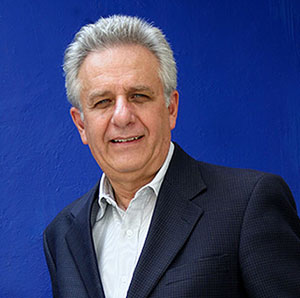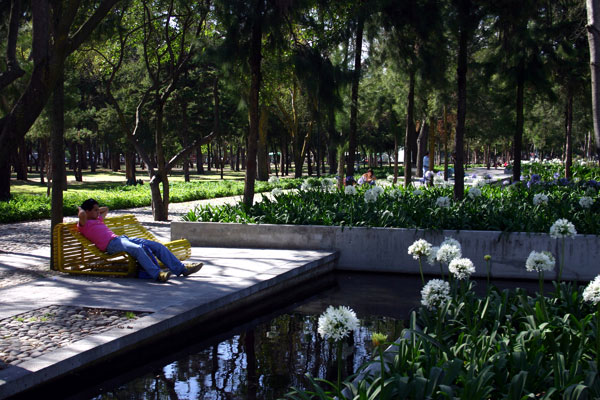News
Interview with Mario Schjetnan, FASLA
 Mario Schjetnan, FASLA
Mario Schjetnan, FASLA
A number of your projects have won ASLA design awards over the years -- most recently, the Fountain Promenade at Chapultepec Park in Mexico City. This park was dedicated by the King of Spain in 1530. What were some of the challenges working with such a historic park?
Working in Chapultepec Park was an honor and a privilege. It was also a great responsibility since Chapultepec has many layers of history, and is charged with symbolism for the Mexican people. It is also the public space "par excellence" in Mexico City. Yes, it's, as you mention, probably the oldest designated public park in the Americas, but also it has been the theatre of many crucial events back from Pre-Hispanic times. It was the source of water for the city, and an aqueduct was built to transport water from the Chapultepec springs to Tenochtitlan, the Aztec's city-island. During the 19th century, Chapultepec became the grounds where the final battle with the U.S. forces was fought and lost (1847) and later the grounds and castle for Maximilian of Hasburg, who tried to establish a European empire in Mexico and the Americas. During the early 20th Century (1908), Chapultepec was implemented as a major public park, in the manner of the Bois de Boulogne in Paris. During the mid-20th Century, major museums were built in Chapultepec: the Museum of National History (established in Chapultepec Castle), the National Museum of Anthropology, the Museum of Modern Art, and the Tamayo Museum of Contemporary Art.
The challenge was to intervene in the park through a restoration which addressed important issues, such as infrastructure and forestry conditions, services, vendors and redistribution of visitors (several places were under-used and others over-used). In other words, we could not do a "cosmetic" intervention. Also, we need to re-establish the notion of Chapultepec as an important historical and botanical place, not just the accumulation of masses of people visiting certain popular "attractions."
 ASLA 2008 Professional General Design Honor Award. Fountain Promenade at Chapultepec Park, Mexico City, Mexico / Francisco Gomez Sosa
ASLA 2008 Professional General Design Honor Award. Fountain Promenade at Chapultepec Park, Mexico City, Mexico / Francisco Gomez Sosa
Within the established goals set in the Master Plan, a major challenge was then to communicate how they were going to be accomplished, what it involved interms of specific projects, time, investments and strategies for implementation. For instance, the park was closed down for seven or eight months.
The recent restoration of the park came out of a ‘bottom-up’ movement by citizens groups like the Citizen’s Regent Group, and the Revive Chapultepec Board of Donors. $1 million for the restoration of the park came from donations at supermarkets and metro stations. These groups then approached the Mayor of Mexico City about the need for a new master plan and restoring the park. Then, out of the USD 25 million needed for the initial master plan projects, half came from donations. How did you channel citizen involvement into the design process? Given the city-wide interest in your work, how did you develop a communications strategy?
We had very good leaders in both the Citizen's Council and the Board of Donors. We participated in many presentations to various citizen's groups both to communicate the Plan and to look for posible donors. Other presentations were done to the media, including TV and newspapers. Other key issues, which were extremely sensitive, such as extracting sick, dead or small trees or emptying lakes and canals, were presented in coordination with city authorities and special presentations were organized with tours for the media. Still, we had to "weather" criticism. Again, the leadership was great, in particular Mrs. Marinela Servitje, Director of the Board of Donors and others from the Citizen's Council which included a respected literature writer, newspaper columninist, popular singer, wife of important TV news anchor, etc.
In this project, we learned of the importance of communication -- the need to convince, accompany leadership, be available, express passion and commitment, listen and be humble, but sometimes also answer back, write, and fight.
The Malinalco House residential landscape project includes a reflecting pool, orchids, cacti, and stone. What were your inspirations? What are your thoughts about the bold, bright Luis Barragan colors? Seeing it – I thought the house could have been in India, or many other places – it has a universal quality.
My house in Malinalco represents an oasis for me and my family, a place away (but fairly close) from Mexico City, to entertain and have friends and family. A place to think and read. To establish a contrast to the lifestyle of Mexico City in a traditional Mexican town. The concept was to have a house and garden, or maybe a garden and a house, inextricably intertwined. To erase the outdoor-indoor dichotomy. To have a microcosmos of stone, water, trees and plants, with an architecture of timeless quality and a reference to traditional houses in the town without trying to copy or reproduce. As my family has changed and grown, we have been able to adapt and enlarge it over 25 years without losing the original spirit. Without being an expert, I have been planting and reproducing orchids in their natural environment.
Many people have mentioned its affinity to various cultural traditions, with a central patio, and its simplicity.
 Malinalco House / Mario Schjetnan
Malinalco House / Mario Schjetnan
Mexico City is a global mega-city. Has the city successfully protected its existing parks and green spaces as its population and geographic size has grown? How is green space allotted among the population – is there equal access for wealthier and poorer areas? As you know, there are green justice issues – unequal access to parks - in cities like NYC. Are the challenges mostly related to changing government policies, or finding financial resources?
Mexico City and surroundings is an enormous conglomerate, a megalopolis of many contrasts. There is the world class city with its great museums, a few great parks and its deep history, with many European, pre-Hispanic and north American influences. A city of certain sophistication in the arts, music, cinema and architecture, and a center of many important universities. But it is also a third world mega-city of contrasts and contradictions: chaotic traffic, rapid growth and development, including an informal sector of enormous dimensions with eruptions in street markets and vendors, uncontrolled squatter settlements, subcultures, illegal taxis and air pollution.
Parks and open space play an important role within this descibed context: not only as social spaces for people of poor and middle income condition, but as urban elements of order and reference, of ecological balance and spaces that make the city "breath".
In answering the question in a quantitative and normative aspect, there are only 1.7 m2/inhabitant of green space in this city as compared with European cities such as Berlin, which have 22m2/ inhabitant or American cities of 10 or 12m2/inhabitant. (Look into the "Urban Age" publications conducted by the London School of Economics and Deutsche Bank).
The lack of public open space is more critical in the poor areas an even more in the informal suburban areas. Therefore, new urban parks are a necessity and important mechanisms to provide social justice. Fortunately, new parks and plazas are being planned by the various political and administrative entities. However since development and urbanization is rapid, with many other needs, there is always a "trailing back."
Interestingly, today, of the 20 largest mega-cities in the world, 15 are in the so called emerging economies, cities such as Sao Paulo, Beijing or Cairo. Cities with similar conditions and problems as well as opportunities, in particular to landscape architects.
What lessons can the global south – developing countries – teach developed countries about landscape architecture, and sustainability?
The global south and/or emerging economies can teach several things in terms of sustainability to the developed economies, in particular to their large cities. The emerging or developing countries can learn a lot in terms of the profession and discipline of landscape architecture as conducted and practiced in these societies.
In terms of the U.S.A., there was an analysis done by the German architect Thomas Herzog in terms of the energy per inhabitant consumed by 20 global cities.
You have taught at Harvard, and returned to the university where you received your Master’s degree – U.C. Berkeley – to give lectures. How has landscape architecture education changed over the past twenty years? How do you think it needs to change in the future?
This is a difficult question to answer. We cannot generalize, but twenty years ago, computer programs were practically non-existent in the studio. So, the first notion of difference in education relates to the availability of information, the capacity to analyse and interpret natural systems simpler and faster, the capacity to have information on the web or google earth in relation to cities, sites, and cultures around the world.
The second notion is that literally the world has become smaller with the availability to travel and communicate. There is an expansion of the studio to the global level. Today, any school can hold global studios with sites around the globe. There are more international students in studios. There is also a tendency to conduct associated or parallel studios with other universities abroad. All of this is fantastic, and has expanded the possibility to explore richer, wider and more complex issues, sites and problems.
However, the key question is if instructors have also adapted to this new global condition by asking the right questions -- if they understand the diversity of cultures and specificity of sites, their complexities and particularities. In addition to theoretical knowledge, great cultural understanding is demanded of instructors. Otherwise, the answers and proposals will be mechanical and simplistic. The availability of sophisticated programs to represent and model may sometimes mislead efforts to analyse, synthetize, reflect, propose and create.
In a recent interview with Laurie Olin, Olin listed you as one of his favorite landscape architects. Is there work that particularly interests you in the U.S., elsewhere in Latin America, or worldwide?
First, I appreciate and value the opinion of Laurie Olin. Laurie precisely represents the combination of academic-practitioner which I was trying to elucidate in my earlier answer. He's a person with a broad cultural foundation and perspective, a great sensibility, and a refined aesthete. An intellectual with clear ideas and insights. And a practical and accessible person. With regards to my practice, most of my work has been in done in Mexico, a country with great ecological, geographical and cultural diversity, and in Mexico City. I have also been fortunate to experience and participate in projects in various parts of the world, (Shenzhen, China; Beirut, Lebanon; Tel Aviv, Israel; Valparaiso, Chile; Medellin, Colombia; Costa Rica, Panama, and in the U.S.A. -- California, Oakland, Napa). My aspiration is to participate in other public or private institutional projects in the U.S.A. or Canada. I look forward to that challenge and opportunity.
But most of all I look forward to opportunities (wherever they are) that are well-realized, serve their purpose, transform a place in a positive manner, people will like and, by using it, will be positively affected or influenced.
Mario Schjetnan started his own firm Grupo de Diseno Urbano (GDU) in 1977. Schjetnan is winner of numerous awards, including the 2008 ASLA General Design Honor Award and the Green Prize in Urban Design from Harvard University. Schjetnan has lectured at U.C. Berkeley, Harvard University, and was director of the School of Landscape Architecture at the University of Arizona, Tucson from 1999 to 2001. A few recent books on the work of Mario Schjetnan and GDU include: Mario Schjetnan: Landscape, Architecture, and Urbanism, and Ten Landscapes: Mario Schjetnan.
Interview conducted by Jared Green.